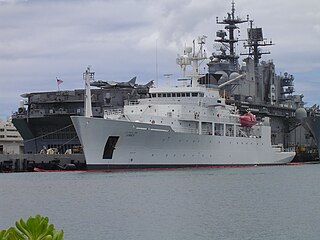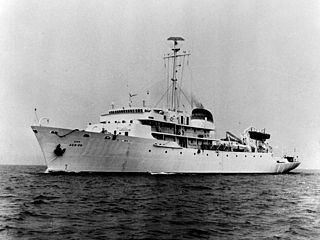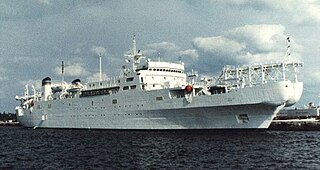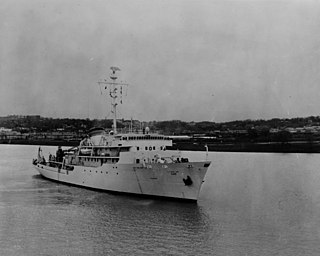USS or USNS Maury may refer to the following ships, named for Commodore Matthew Fontaine Maury:

USNS Mizar (MA-48/T-AGOR-11/T-AK-272) was a vessel of the United States Navy. She was named after the star Mizar.
The Naval Oceanographic Office (NAVOCEANO), located at John C. Stennis Space Center in south Mississippi, is an echelon IV component of the Naval Meteorology and Oceanography Command (NMOC) and comprises approximately 1,000 civilian, military and contract personnel responsible for providing oceanographic products and services to all elements within the Department of Defense.

USNS Sumner (T-AGS-61) is a Pathfinder-class oceanographic survey ship that became operational in 1997. It is the fourth United States Navy ship named Sumner, in this case for Thomas Hubbard Sumner, an American sea captain who discovered the principles of celestial navigation by circle of equal altitude. These ships are crewed by a small crew of civilian mariners, supporting an even smaller contingent of United States Navy personnel.

USNS Pathfinder is a United States Navy oceanographic survey ship, and the lead vessel of her class. Her mission is to collect acoustical, biological, physical, and geophysical surveys of the world's oceans. This data has many uses, but a primary focus is characterizing the ocean environment in order to improve the U.S. Navy's undersea warfare capabilities.

USNS Henson (T-AGS-63) is a Pathfinder-class oceanographic survey ship. It is the fourth ship in the class. Henson is named after Matthew Henson, who accompanied Robert Peary, most famously on an expedition intended to reach the Geographic North Pole in 1909.

USNS Adventurous (T-AGOS-13) was a Stalwart-class modified tactical auxiliary general ocean surveillance ship of the United States Navy in service from 1988 to 1992. She was in non-commissioned service in the Military Sealift Command from 1988 to 1992, operating during the final years of the Cold War. She was transferred to the National Oceanic and Atmospheric Administration (NOAA) in 1992 and in 2003 was commissioned into service with NOAA as the fisheries research ship NOAAS Oscar Elton Sette.

USNS Capable (T-AGOS-16) was a Stalwart-class modified tactical auxiliary general ocean surveillance ship of the United States Navy in service from 1989 to 2004. In 2008, she was commissioned into service in the National Oceanic and Atmospheric Administration as the oceanographic research ship NOAAS Okeanos Explorer.

NOAAS Thomas Jefferson is a National Oceanic and Atmospheric Administration (NOAA) hydrographic survey vessel in service since 2003. The ship was built for the United States Navy as USNS Littlehales (T-AGS-52) serving as one of two new coastal hydrographic survey vessels from 1992 until transfer to NOAA in 2003 when it was named after Founding Father and third U.S. president, Thomas Jefferson.

USNS Lynch (T-AGOR-7) was a Robert D. Conrad-class oceanographic research ship that served the United States Navy from 1965 to 1994. During that period the ship was one of the ships under the technical direction of the Naval Oceanographic Office (NAVOCEANO) operating as an Auxiliary General Oceanographic Research (AGOR) program "pool" ship for support of Navy laboratories on each coast as well as NAVOCEANO projects. Lynch was assigned to support laboratories on the East Coast.

USNS Silas Bent (T-AGS-26) was a Silas Bent class survey ship acquired by the United States Navy in 1964 and delivered to the Military Sealift Command in 1965. Silas Bent spent her career in the Pacific Ocean performing oceanographic surveys. The ship was equipped with the Oceanographic Data Acquisition System (ODAS) as were the later oceanographic survey ships USNS Kane (T-AGS-27) and USNS Wilkes (T-AGS-33).

USNS S. P. Lee was laid down on 27 June 1966 by the Defoe Shipbuilding Co., Bay City, Michigan as yard hull number 441. The ship, sponsored by Mrs. David Scull, great-granddaughter of Admiral Lee, was launched on 19 October 1967 and delivered to the navy on 2 December 1968.

USNS Zeus (T-ARC-7) is the first cable ship specifically built for the United States Navy. Though planned to be the first of two ships of her class, the second ship was not built, leaving Zeus as the only ship of her class. She is capable of laying 1,000 miles (1,600 km) of cable at depths of up to 9,000 feet (2,700 m).

USNS Marie Tharp (T-AGS-66) is a Pathfinder-class oceanographic survey ship operated by the Military Sealift Command of the United States Navy. The seventh ship in her class, Marie Tharp is named for oceanographer Marie Tharp; the ship was renamed in 2023 from Maury.

USNS John McDonnell (T-AGS-51) was a hydrographic survey ship operated by the Military Sealift Command (MSC) with a contract crew for the Naval Oceanographic Office which assigned a military and civilian hydrographic detachment to conduct coastal surveys. The ship and its sister, USNS Littlehales (T-AGS-52), were replacements for the coastal hydrographic survey vessels USNS Chauvenet (T-AGS-29) and USNS Harkness (T-AGS-32).

USNS Kane (T-AGS-27) was a Silas Bent-class survey ship acquired by the United States Navy and delivered to Military Sealift Command in 1967. Kane spent her career performing oceanographic surveys. The ship was equipped with the Oceanographic Data Acquisition System (ODAS) as were oceanographic survey ships USNS Silas Bent (T-AGS-26) and USNS Wilkes (T-AGS-33).

USNS Chauvenet (T-AGS-29) was a multi-function survey ship laid down on 24 May 1967, at Upper Clyde Shipbuilding Corp., Glasgow, Scotland. The ship was the second survey ship, Chauvenet (AGS-11) being the first, named for William Chauvenet (1820-1870). He was instrumental in the founding of the United States Naval Academy at Annapolis, MD. The mathematics department of the US Naval Academy in Annapolis was founded by Chauvenet and is housed in Chauvenet Hall. Chauvenet was launched on 13 May 1968, delivered to the US Navy, 13 November 1970 and placed in service with the Military Sealift Command (MSC) as USNS Chauvenet (T-AGS-29). The ship conducted coastal hydrographic and topographic surveys under the technical direction of the Oceanographer of the Navy through the U.S. Naval Oceanographic Office (NAVOCEANO). The ship was assigned to the Pacific for surveys, sister ship Harkness (T-AGS-32) was assigned Atlantic duties, doing so until inactivated in November 1992.















